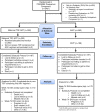Impact of postpartum tenofovir-based antiretroviral therapy on bone mineral density in breastfeeding women with HIV enrolled in a randomized clinical trial
- PMID: 33544759
- PMCID: PMC7864465
- DOI: 10.1371/journal.pone.0246272
Impact of postpartum tenofovir-based antiretroviral therapy on bone mineral density in breastfeeding women with HIV enrolled in a randomized clinical trial
Abstract
Objectives: We set out to evaluate the effect of postnatal exposure to tenofovir-containing antiretroviral therapy on bone mineral density among breastfeeding women living with HIV.
Design: IMPAACT P1084s is a sub-study of the PROMISE randomized trial conducted in four African countries (ClinicalTrials.gov number NCT01066858).
Methods: IMPAACT P1084s enrolled eligible mother-infant pairs previously randomised in the PROMISE trial at one week after delivery to receive either maternal antiretroviral therapy (Tenofovir disoproxil fumarate / Emtricitabine + Lopinavir/ritonavir-maternal TDF-ART) or administer infant nevirapine, with no maternal antiretroviral therapy, to prevent breastmilk HIV transmission. Maternal lumbar spine and hip bone mineral density were measured using dual-energy x-ray absorptiometry (DXA) at postpartum weeks 1 and 74. We studied the effect of the postpartum randomization on percent change in maternal bone mineral density in an intention-to-treat analysis with a t-test; mean and 95% confidence interval (95%CI) are presented.
Results: Among 398/400 women included in this analysis, baseline age, body-mass index, CD4 count, mean bone mineral density and alcohol use were comparable between study arms. On average, maternal lumbar spine bone mineral density declined significantly through week 74 in the maternal TDF-ART compared to the infant nevirapine arm; mean difference (95%CI) -2.86 (-4.03, -1.70) percentage points (p-value <0.001). Similarly, maternal hip bone mineral density declined significantly more through week 74 in the maternal TDF-ART compared to the infant nevirapine arm; mean difference -2.29% (-3.20, -1.39) (p-value <0.001). Adjusting for covariates did not change the treatment effect.
Conclusions: Bone mineral density decline through week 74 postpartum was greater among breastfeeding HIV-infected women randomized to receive maternal TDF-ART during breastfeeding compared to those mothers whose infants received nevirapine prophylaxis.
Conflict of interest statement
The authors have declared that no competing interests exist.
Figures



References
Publication types
MeSH terms
Substances
Associated data
Grants and funding
LinkOut - more resources
Full Text Sources
Other Literature Sources
Medical
Research Materials

